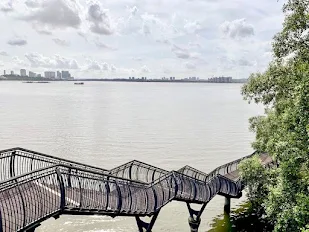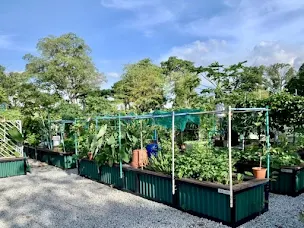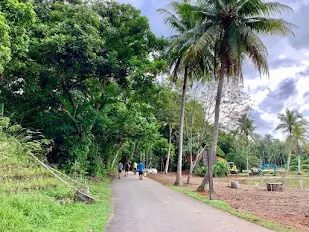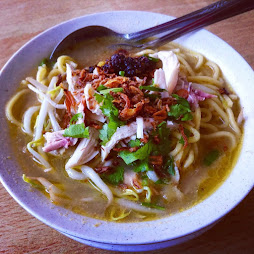 |
HDB block of flats
|
Singapore, a small island city-state in South-East Asia, very near the equator, has the unenviable title of the world's most expensive city, well, according to some surveys. Singapore is an expensive place to stay and live in. When many of the residents wear t-shirts, shorts and flip-flops most of the time partly due to hot and humid weather, how can the city be an expensive place to live in?
Singapore has the highest GDP per capita in Asia. It is a city, a country, consisting of a cluster of 63 islands, the total land area which is only 720 square kilometres but with a population of 5.6 million. That’s pretty dense. Owning properties and cars are expensive. 80% of the population live in housing and development board (HDB) flats. However, 'public' housing here is not exactly cheap. And some who live in HDB flats are not necessarily poor either. There are million dollars HDB flats! Insane right?
 |
| "Home" wall mural at Tiong Bahru |
Fortunately unless you despise getting squeezed in crowded mass rapid transit (mrt) trains or public buses and willing to fork out high monthly car loan payment, the country has pretty good public transportation system. Except these tend to be very crowded during peak hours. And the trains do break down occasionally.
Maybe the transit system reliability not in the league of Japan or Taipei, but I think it is similar to that of the London tube or the Paris metro. At least there are no workers strikes. Though not having strikes may seem to make this country rather strerile.
Taxis are relatively inexpensive especially when there are few people sharing the taxis and if you ride during non-peak hours. Taking taxis during peak morning and evening hours will add 25% to the metered cost. And taking taxis between midnight to six in the morning will incur 50% more. And there are some other surcharges as well such as taking taxis from the airport. But unfortunately if we need a transport after midnight the choices are limited.
There are night buses but they only ply certain routes and they run during weekends only. Buses are generally an affordable way to move around just like MRT. But buses are circuitous and a non-productive way to move around except for shorter distances. But if you have time to spare some routes can be quite scenic. And buses just like MRT are distance based so if the bus goes round and round the cost can add up. So now there is Uber and Grab Taxi to add to the mix of public transportation.
Fortunately while eating at restaurants can be an expensive affair, a typical buffet lunch or dinner at a hotel restaurant here cost about $50 to $80++, eating at
hawker centres and food centres or food-courts are quite affordable and many dishes are tasty. People always say the tastiest meal is the stall that attracts the longest queue, well, if you have the time. One can eat nicely for between $3 to $5.
This website will try to highlight some of the many delicious meals, recreation, activities, places to visit that you can enjoy for less. You can get
laksa, chicken rice, char kway teow, rojak, nasi lemak,
soto or mee soto, mee siam,
mee goreng, mee rebus, yong tau foo,
thosai,
roti prata,
chapati, etc., for less than $5. Eating cheap does not mean less tasty.
However if you crave for the iconic chilli crabs that will cost much much more!And while a stick of
satay cost only 60 cents, having a set of 10 sticks complete with ketupat or glutinous rice will still cost less than $10. So you can indeed eat well for a few dollars more without resorting to that good old maggie mee. Though boiling and slurping maggie mee once in a while is pretty comforting. Especially when you add egg and some veggies.
Sedap.
Even fast-food restaurants have
breakfast deals that cost $5. Such as the good old
porridge meal with coffee or tea or pancakes meals with the good old iced milo. We all love that comfort food, porridge or congee.
Many activities can be done for free or at minimal cost such as going to the
public or community libraries, where you can read and borrow books or watch some educational media, even movies. Going to the parks are also free. And there are also
exercise corner within some parks where you can do some workout.
Well, we can actually get a good sweat by strolling and enjoying our many parks here such as at Sungei Buloh Wetland,
Pasir Ris Mangroves Park,
MacRitchie Reservoir or Windsor Nature Park for the tree-top walk,
Coney Island for the lush casuarina trees and at Pulau Ubin. There are sandy beaches at
Sentosa Island, East Coast Park,
Changi Beach and at
Punggol Point. Ok, maybe the beaches here are not in the league of some beaches in Thailand, Malaysia or Bali, but it is alright.
 |
| Sungei Buloh Wetlands overlooking Johor |
At
Sungei Buluh Wetland Reserve you may be able to spot crocodiles and the fantail observation pods are really cool. At
Pulau Ubin you can enjoy Chek Jawa marine wetland using the boardwalk and perhaps go for bicycle rides around the island.
Pasir Ris Park has mangrove forest with some diverse birds if you are into bird watching, similar to
Sungei Buloh and Pulau Ubin. You don't have to go all the way to the Amazon jungle when the tropical rainforest are right here in urban Singapore.
 |
| Wall mural of men at a coffee-shop |
Apart from
Pulau Ubin, if you enjoy cycling, which is a healthy and fun activities, you can also rent bicycles at East Coast Park,
Changi Beach,
Punggol Point/ Coney Island and at
Pasir Ris. There are park connectors that connect cycling paths between the various cycling stations mostly in the easten part of Singapore. So you can start your cycling at say Pasir Ris and head to Tampines or Bedok Reservoir and return your bikes there.
 |
| Rickshaw on display at National Museum |
Though the hot and humid conditions in Singapore means the best time to cycle is early morning or late afternoon. There are cyclists from cycling clubs here who cycled at night and their favourite cycling route is along Changi Coast Road which is parallel with the airport runway.
Though with the new terminal slated to be built, there is likely to be diversion towards the beach. We definitely are not short of parks, gardens and nature reserve. Singapore Botanic Gardens with its amazing
orchid garden is Unesco World Heritage Site. Have you heard of coast to coast trail that starts from
Coney Island and ends at
Jurong Lake Gardens? You can walk the length of Singapore from east to west or vice-versa.
There are
children playgrounds, public gyms or fitness centres at housing estate parks. Parks also have walking pavement for those who wish to have their morning or evening jog. The
public swimming pools cost a minimal fee of $2 or less to enter. Many
museums have free entrance for locals such as the wonderful Asian Civilisation museum, the National Museum and
Changi Museum.
Changi Museum in fact has free entrance for all including tourists though if you rent the headphone for commentaries that will cost you $8. Most
heritage centres are also free for the locals. But the many upmarket restaurants littering the many free
museums such as at National Museum and the National Gallery can make the visits an expensive affair unless we can steer clear of them.













Comments
Post a Comment